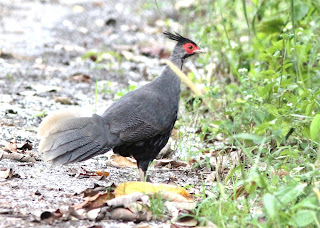On Jan 23rd we arrived at our resort at Khlong Lang, just outside Mae Wong National Park, late in the afternoon in glorious hot sunshine, little did we know how things would change in the next few days. Before dawn next morning we headed into the park and towards the Chong Yen Campsite, stopping at a flowering tree on the way were we saw several Coral-billed Scimiter Babbler and a pair of Striated Yuhina. Carrying on towards the campsite, it did not take long before we hit low cloud and thick fog, things were even worse at the campsite with visibility of just 20-30 meters and temperatures creeping just into double figures.
 |
Flavescent Bulbul
by Fred Rowe |
We hung around the campsite at Chong Yen for several hours, the Flavescent Bulbul's keeping us amused for a while, followed by a pair of Silver-eared Mesia. In a slightly brighter spell of weather we ventured down the Umphang Trail, a number of fruiting and flowering trees, attracted a nice selection of species, which included a very obliging Small Niltava, Speckled Piculet and several Black-throated Sunbird. Species seen in a fast moving, mixed species feeding flock included, Golden-throated Barbet, a male Clickling Shrike Babbler, Lesser Racket-tailed Drongo, Yellow-cheeked Tit, Claudia's and Davison's Leaf Warbler, Sulphur-breasted Warbler and a White-tailed Robin. By mid-afternoon the fog closed in again, so we decided to head down the mountain in search of better weather, finding only more rain and fog, things were brighter but wet at the resort and we abandoned birding for the day, convinced the weather could not be any worse the next day.
 |
Blue Whistling Thrush
by Fred Rowe |
At dawn we again headed into the park, it felt cold, but the fog wasn't as bad, we saw a great selection of pigeons at a stop on the way, with Wedge-tailed, Pin-tailed and Thick-billed Green Pigeon and Mountain Imperial Pigeon in one fruiting tree, along with at least four fly over Barred Cuckoo Dove. Higher up the mountain the weather deteriorated further, becoming colder, winder and wetter, we stopped at a blind which overlooks a stream, a few birds were present here including several Streaked Wren Babbler, 2 White-tailed Robin, a pair of Buff-breasted Babbler, Blue Whistling Thrush and a Hill Blue Flycatcher.
 |
White-tailed Robin
by Fred Rowe |
After an hour and with hypothermia beginning to sent in we left and headed to Chong Yen where the weather was even worse, with heavy rain strong winds and temperatures at 10am of just 7 degree's Celsius, common sense prevailed and we headed back to the resort, seeing 15 Kalij Pheasant on the way down. The rest of the day and the next were spent trying to keep warm, birding around the resort and at nearby Khlong Lan Waterfall, in between spells of heavy rain and strong winds. We managed to find a few birds, including a surprise Forest Wagtail at the resort, where we also saw Pale-legged Leaf Warbler, several Asian Brown Flycatcher and Brown-throated Sunbird and during a short visit to Khlong Lan Waterfall an Eye-browed Thrush and a male Hill Blue Flycatcher.
 |
Kalij Pheasents
by Fred Rowe |
Towards the end of our stay here, it was increasingly apparent that the extreme weather was taking it's toll on some birds, with large numbers of
Swallow and
Red-rumped Swallow sitting around on the grass at our resort and in the road, many in a weak condition, later we went on to find several dead. The extreme weather effected much of Central and Northern Thailand and was probably the coldest spell of weather for many years, with many reports of dead hirundines, swifts and smaller birds, at one point the weather was warmer in the UK than over much of Thailand!.
 |
| Fred and Marian, birding despite the weather! |




















